New South Wales Class 3 Zero Emission Vehicle Mass and Dimension Exemption Notice Operator’s Guide
New South Wales Class 3 Zero Emission Vehicle Mass and Dimension Exemption Notice Operator’s Guide
National
Heavy
Vehicle
Regulator
The New South Wales Class 3 Zero Emission Vehicle Mass and Dimension Exemption Notice 2024 (No.1) provides exemptions from mass requirements under the Heavy Vehicle (Mass Dimension and Loading) National Regulation (MDL) for Class 3 heavy vehicles that are battery electric or hydrogen fuel cell vehicles that meet specified Australian Design Rule (ADR) requirements.
Note: This instrument does NOT exempt these heavy vehicles from other requirements of the Heavy Vehicle National Law (HVNL) including other dimension requirements and mass requirements.
| Specifications | |
|---|---|
| Gazette Notice: | C2024G00342 |
| Starts: | 14 June 2024 |
| Expires: | 26 May 2026 |
| Vehicle types: | Class 3, zero emission vehicle, battery electric vehicle, hydrogen fuel cell vehicle, rigid truck without a trailer, prime mover without a trailer, prime mover towing a semitrailer, B-double |
| Exemptions: | Mass requirements (general combination mass, single vehicle mass, steer axle mass limits, axle mass limits, axle spacing mass limits, axle group mass limits) |
| Law: | HVNL, MDL |
| Coverage: | NSW |
| To be carried: | No |
- Overview
- Definitions
- Eligible
Vehicles - Conditions
- Network and
Mapping - Related
Notices - Resources
- Changes and
Updates
Overview
The information in this Operator’s Guide is intended to do two things:
- Explain how the New South Wales Class 3 Zero Emission Vehicle Mass and Dimension Exemption Notice 2024 (No.1) (the Notice) operates, to assist in complying with it. It is important to remember this Operator’s Guide is instructional only and it is the Notice that provides the exemption or authorisation. If there is a difference or misunderstanding between the Operator’s Guide and the Notice, the Notice has priority and must be followed. The only exceptions are the requirements or conditions set out in the ‘Network and Mapping’ section explained below.
- Provide additional information referred to in the network requirements of the Notice. This includes links to network maps and other information such as vehicle, travel and road conditions. Networks and their conditions published in the Network and Mapping section of this Operator’s Guide are not general advice and must be treated as conditions of the Notice.
Please read the Notice and this Operator's Guide together. To download or print this guide, use the print or PDF buttons on the top right of this page
About the Notice
The Notice provides Class 3 heavy vehicles that are battery electric or hydrogen fuel cell vehicles that meet specified ADR requirements, which are normally heavier than internal combustion engine equivalent vehicles, with exemptions to mass requirements under the MDL thereby enabling them to operate on nominated networks.
Exemptions
These exemptions only apply to the extent to which conditions are granted.
Mass requirements
The Notice exempts an eligible combination from the following general mass requirements specified in Schedule 1 of the Heavy Vehicle (Mass, Dimension and Loading) National Regulation (MDL):
- section 2 – Mass limits for a single vehicle or combination
- section 4 – Mass limits for a single axle group
- section 5 – Mass limits relating to axle spacing generally.
Note: Other mass and dimension limits in the MDL apply.
Definitions
The following are terms used in the Notice or conditions of operation. Unless otherwise stated, words and expressions used in this Notice have the same meaning as defined in the HVNL.
|
Term |
Definition |
|---|---|
|
ADR |
|
|
Class 3 heavy vehicle |
A heavy vehicle is a Class 3 heavy vehicle if:
|
|
GCM |
Gross Combination Mass. |
|
HVNL |
|
|
MDL |
Heavy Vehicle (Mass, Dimension and Loading) National Regulation. |
|
VS Regulation |
|
|
Battery electric vehicles (BEVs) |
Vehicles that use an electric motor and run solely on battery power.* |
|
Hydrogen fuel cell vehicles |
Vehicles that convert fuel into energy through an electrochemical reaction with hydrogen and oxygen. This produces electricity which powers an electric motor.* |
|
ZEHV |
Zero Emission Heavy Vehicle. |
|
*Source: Department of Infrastructure, Transport, Regional Development, Communications and the Arts |
|
Eligible vehicles
To be eligible to operate under the Notice, approved combinations must comply with the conditions of the Notice and all other requirements of the MDL, except where specifically exempted by the Notice.
| Description | Image of eligible vehicle |
|---|---|
| Rigid truck or prime mover without a trailer | |
| Rigid truck - Single drive axle (dual tyres) |  |
| Rigid truck - Tandem axle group (dual tyres per axle) |  |
| Rigid truck - Tri-axle group (dual tyres per axle) |  |
| Prime mover - Single drive axle (dual tyres) |  |
| Prime mover - Tandem axle group (dual tyres per axle) |  |
| Prime mover towing a trailer | |
| Prime mover towing a trailer with a tandem axle group fitted with 8 tyres |  |
| Prime mover towing a trailer with a tri-axle group fitted with 12 tyres |  |
|
B-double |
 |
Conditions
Notices are subject to various conditions to ensure public safety, protect assets and prevent adverse impacts on the community, such as noise, emissions and traffic congestion. See the sections below for specific conditions related to the Notice.
Mass conditions - Click to expand
Mass limits for rigid trucks and prime movers
A rigid truck or prime mover that forms part of an eligible vehicle that is listed in column 1 of Table 2, and that has a drive axle group described in column 2, must not exceed the following mass limits:
- the maximum vehicle mass stated in column 3;
- steer axle mass – 8.0t; and
- the maximum mass on the drive axle or axle group as stated in column 4.
| Column 1 | Column 2 | Column 3 | Column 4 |
|---|---|---|---|
| Eligible vehicle | Drive axle of axle group | Maximum vehicle mass (t) | Drive axle or axle group (t) |
| Rigid truck - Single drive axle (dual tyres) |  |
18.0 | 10.5 |
| Rigid truck - Tandem axle group (dual tyres per axle) |  |
26.0 | 18.5 |
| Rigid truck - Tri-axle group (dual tyres per axle) |  |
27.0 | 21.0 |
| Prime mover - Single drive axle (dual tyres) |  |
18.0 | 10.5 |
| Prime mover - Tandem axle group (dual tyres per axle) |  |
26.0 | 18.5 |
Note: Regardless of any conditional mass limits contained in the Notice, an eligible vehicle must not exceed manufacturer’s mass limits as defined in section 8(8) of the MDL.
Prime mover mass limits
ZEHV prime movers are limited to the following masses:
- single steer axle and single drive axle 18t maximum.
- single steer axle and tandem drive axle 26t maximum.
These mass limits apply to all prime mover and semitrailer and B-double combinations.
Prime mover and semitrailer combination mass limits
There are three main mass limits for eligible vehicles operating under the notice: M1, M2, and M3. These are determined based on whether the trailer axle groups can have increased masses if the operator is accredited under Mass Management and/or if the axle group is fitted with certified road-friendly suspension (RFS) systems.
M1 – the trailer axle group masses comply with the general mass limits (GML) stated in the HVNL.
M2 – the trailer axle group masses have additional mass allowances like those allowed under concessional mass limits (CML).
M3 – the trailer axle groups have increased mass limits like those allowed under higher mass limits (HML).
| Eligible vehicle | Axle configuration | Trailer configuration | Maximum combination mass (t) | ||
|---|---|---|---|---|---|
| M1 | M2 | M3 | |||
| Prime mover | Single steer axle and single drive axle | Trailer fitted with a single-axle | 27.0 | - | - |
| Trailer fitted with a tandem axle | 34.5 | 35.0 | 35.0 | ||
| Trailer fitter with a tri-axle group | 38.0 | 39.0 | 40.5 | ||
| Single steer axle and dual-drive-tandem axle group | Trailer fitted with a single-axle | - | - | - | |
| Trailer fitted with a tandem axle group | 42.5 | 43.0 | - | ||
| Trailer fitted with a tri-axle group | 46.0 | 47.0 | 48.5 | ||
| B-double with trailers fitted with tri-axle groups | 66.0 | 68.0 | 71.0 | ||
Trailer axle group mass limits
An axle group on a trailer that forms part of an eligible vehicle described in column 1 and pictured in column 2 of Table 4 must not exceed the mass limit specified in column 3.
| Column 1 | Column 2 | Column 3 |
|---|---|---|
| Trailer axle group | Trailer axle group image | Trailer axle group mass limit (t) |
Tandem axle group fitted with 8 tyres, and where:
|
 |
17.0 |
| Tri-axle group fitted with 12 tyres, and where the operator holds Mass Management Accreditation. |  |
21.0 |
Tri-axle group fitted with 12 tyres, and where:
|
 |
22.5 |
Axle spacings conditions
For all eligible vehicles, the minimum distance between the centreline of the axles of any given axle group must be 1.2m.
The minimum distance between the centrelines of the steer axle and the first axle of the drive axle group:
- Prime mover: 3.0m.
- Rigid truck: 3.3m.
Rigid truck axle spacings
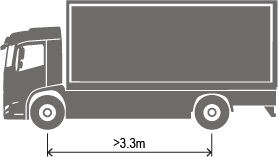
Note: The total mass of the rigid truck is 18.0t.
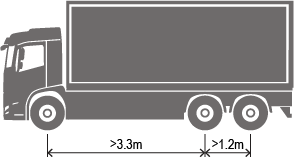
Note: The total mass of the rigid truck is 26.0t.
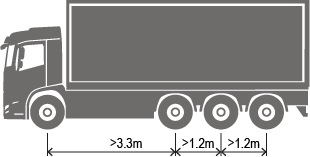
Note: The total mass of the rigid truck is 26.0t (M1), 27.0t (M2).
Prime mover towing a semitrailer
For a prime mover towing a semitrailer, the minimum distance between the centrelines of the rear axle of the drive axle group and the first axle of the trailer must be 4.4m.
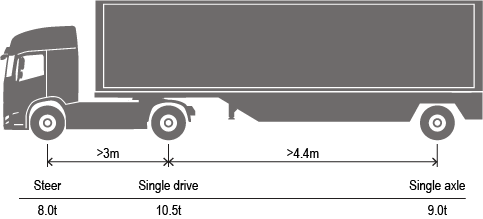
Note: The GCM is 27.0t.
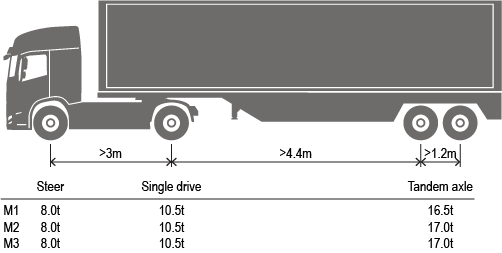
Note: The GCM is 34.5t (M1) and 35.0t (M2 /M3).
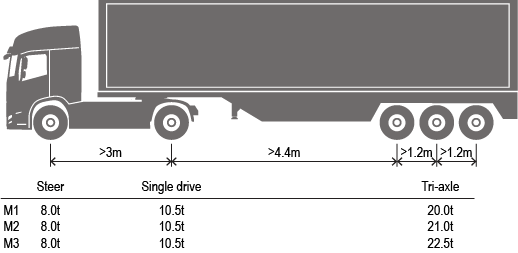
Note: The GCM is 38.0 t (M1), 39.0t (M2), and 40.5t (M3).
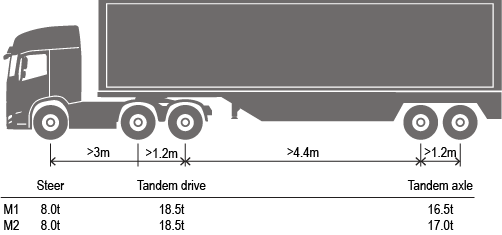
Note: The GCM is 42.5t (M1) and 43.0t (M2).
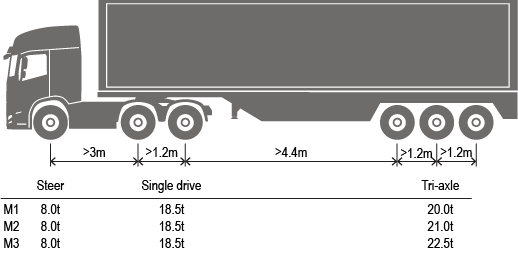
Note: The GCM is 46.0t (M1), 47.0t (M2), and 48.5t (M3).
B-doubles
For an eligible vehicle that is a B-double, the distance between the axle pairs specified in column 1 of Table 5 must fall within the range provided in columns 2 and 3.
| Column 1 | Column 2 | Column 3 |
|---|---|---|
| Axle spacing | Not less than (m) | Not more than (m) |
| Between the rear axle of the drive axle group to the first axle of the first trailer | 5.5 | 6.5 |
| Between the rear axle of the first trailer to the first axle of the second trailer | 5.5 | 6.8 |
B-double tandem drive with tri-axle semitrailers (26m long)
B-doubles operating under this Notice must comply with the ‘clear spacing rule’. This rule is explained in the IPAC-5 V1 - X-Y Rule check on PBS Design Approvals (PDF, 403KB).
The X-Y Rule, also known as the 'clear spacing rule', is defined in Schedule 6, section 10 of the MDL.

Note: The GCM is 66.0t (M1), 68.0t (M2), and 71.0t (M3).
General conditions - Click to expand
- Tyres on the steer axle of an eligible vehicle must be at least 385mm in width.
- For an eligible vehicle that is a B-double, all trailers must be fitted with tri-axle groups.
- An eligible vehicle must be fitted with dual tyres on the drive axle or drive axle group.
Conditions – Intelligent access program conditions (IAP conditions)
An eligible vehicle must be enrolled in and comply with the following approved intelligent transport systems approved by Transport Certification Australia:
- Road Infrastructure Management (RIM): When operating an eligible vehicle with a single drive axle group of up to 10.5 tonnes, a tandem drive axle group with up to 18 tonnes, or a tri-axle drive group with up to 21 tonnes.
- Telematics Monitoring Application (TMA): When operating an eligible vehicle with a single drive axle group of up to 10.5 tonnes or tandem drive axle group with up to 18 tonnes and in a combination operating at M3 masses.
- TMA and Smart On-Board Mass Monitoring (OBM): When operating an eligible vehicle with a tandem drive axle group above 18 tonnes up to 18.5 tonnes.
ZEHVs enrolled in a TMA ZEHV Monitoring Scheme, which is a higher level of assurance, do not need to be enrolled in the RIM ZEHV Monitoring Scheme.
| Axle group | Telematics application | ||
|---|---|---|---|
| RIM | TMA | TMA and OBM | |
| Masses up to (t) | |||
| Single drive axle | 10.5 | 10.5 | - |
| Tandem drive axle group | 18.0 | 18.0 | Above 18.0 |
| Tri-drive axle group | 21.0 | - | - |
| Trailer tandem axle groups | 17.0 | - | - |
| Trailer tri-axle groups | - | 22.5 | - |
Other conditions and additional information
Assessing routes
Before an eligible vehicle is driven along any route, its driver and operator must be satisfied that the route has been assessed and that the vehicle can be driven along it without:
- disrupting telecommunication, electricity, rail, gas, water or sewage services; or
- damaging a road (including a bridge), structure, rail crossing or tree.
Third party approvals
Gazette notices, permits and some jurisdictional laws may require third parties and other entities to provide permission for a vehicle to travel if it exceeds certain mass or dimension limits.
Operators must secure all approvals from third parties such as electricity/utility companies, rail authorities and other third parties as part of their heavy vehicle operations.
For more information, visit the Third party approvals page.
Warning signs
Eligible combinations longer than 22m but not longer than 30m must display a long vehicle warning sign at the vehicle's rear (as shown in Figure 10).
Warning sign requirements are described in the NHVR's Vehicle Standards Guide (VSG-19).
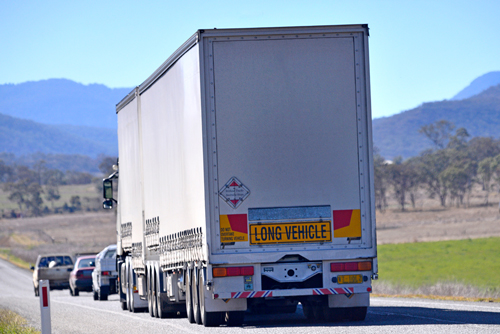
Complying with the HVNL
Unless otherwise exempted by the Notice or this Operator's Guide, operators must ensure their vehicle or combination complies with the:
- Australian Design Rules (ADRs); and,
- Heavy Vehicle National Law (HVNL); and,
- Heavy Vehicle (Mass, Dimension and Loading) National Regulation (MDL); and,
- Heavy Vehicle (Vehicle Standards) National Regulation (VS Regulation).
Using or permitting another person to use a defective heavy vehicle or a heavy vehicle with unapproved modifications on a road may be an offence.
Failure to comply may result in the driver and/or operator being liable for an offence. Penalties can include infringement notices or prosecution.
Chain of Responsibility (CoR)
Under the HVNL, every party in the Chain of Responsibility (CoR) has a positive duty to ensure the safety of their activities in relation to a heavy vehicle. This duty, known as the “primary duty”, applies to the scheduling, loading and consigning of a vehicle, as well as to its operation on a road.
Safety is broader than the safety of drivers and other road users. It also includes protection of road infrastructure, preventing damage to other vehicles or property, and minimising environmental harm. Substantial penalties may be imposed upon parties who breach this obligation and upon their executives.
For more information on your CoR obligations visit Chain of Responsibility on the NHVR website.
Our Regulatory Advice offers guidance, tips and tools for managing a range of heavy vehicle safety risks.
Loading requirements
To meet the loading requirements, the heavy vehicle must be loaded:
- in a way that load placement does not make the heavy vehicle unsafe or unstable
- in a way that the load is not likely to fall or be dislodged from the vehicle
- using an appropriate system to restrain the load.
Visit the NHVR loading page for more information on load requirements.
The requirement to carry the Notice
Drivers do not need to carry a copy of the Notice.
Network and mapping
For the purposes of s121 of the HVNL, an area or route specified in the 'Network & Mapping' section of this Operator's Guide is a stated area or route to which this Notice applies. In addition to complying with the conditions stated in this Operator's Guide, operators must ensure compliance with the specific road manager access requirements set out below or in network maps.
In this tab, you will find the approved routes authorised under the Notice. There may also be network conditions pursuant to the stated areas and routes under the Notice. Network conditions relate to road and travel conditions that are not contained within the Notice.
National Network Map
From 20 December 2023, certain authorised heavy vehicle road network maps for the Australian Capital Territory, New South Wales, Queensland, South Australia, and Victoria are published by the National Heavy Vehicle Regulator, through the NHVR National Network Map. Additional information and guidance can be found on the National Network Map webpage.
Approved routes covered by the Notice
Routes approved for travel for vehicles eligible under the Notice can be found on the National Network Map by clicking on 'NSW Zero Emission Vehicle maps'.
Approved routes covered by the Notice - Click to expand
An eligible vehicle that is a rigid truck or prime mover without a trailer can access the 'ZEHV Rigid trucks (M1 and M2)' network.
An eligible vehicle that is a combination listed in column 1 of Table 7 that does not exceed the axle mass limits stated in columns 2 to 4 may access the networks listed in column 5.
| Column 1 | Column 2 | Column 3 | Column 4 | Column 5 |
|---|---|---|---|---|
| Combination | Trailer single axle (t) | Trailer tandem axle group (t) | Trailer tri-axle group (t) | Network |
| Prime mover towing a semitrailer | 9.0 | 17.0 | 21.0 | ZEHV Short Combination (M1 and M2) |
| 22.5 | ZEHV Short Combination (M3) | |||
| B-double | N/A | N/A | 21.0 | ZEHV B-double (M1 and M2) |
| N/A | N/A | 22.5 | ZEHV B-double (M3) |
Regardless of Table 7, an eligible vehicle that is a prime mover towing a semitrailer where the trailer has a tandem axle group and road-friendly suspension but is not enrolled in mass management accreditation, that vehicle is limited to 'ZEHV Short Combination (M3)'.
The 'NSW Zero Emission Vehicle maps' can be found on the National Network Map.
Each ZEHV mapped network has a list of eligible reference vehicles and their mass limits.
Specified road manager network requirements
The following section outlines specific road manager route requirements under the Notice, including route conditions and restrictions.
Road manager route requirements in this section may change from time to time and should be reviewed regularly to ensure compliance.
For further information on how to comply with a requirement, please contact the relevant road manager.
Road managers may publish specific route conditions and restrictions on the approved network map. These must be complied with in addition to any route requirements outlined in this Operator's Guide. If a condition listed in any section of this Operator's Guide conflicts with a route condition or restriction published on an approved network map, the more restrictive requirement applies.
Non-participating road managers
This section lists road managers that have not yet provided support for the Notice.
Access to local roads in non-participating council areas is not approved for any combination under the Notice.
Access to state roads on the approved nominated networks in non-participating council areas is allowed, subject to Notice and network conditions.
Operators can apply for access to local roads in non-participating council areas by submitting a permit application through NHVR Go.
Traffic advisory services - Click to expand
Prior to commencing any journey, operators should review traffic alerts, road closures, travel delays, and other traffic advisory information for participating jurisdictions.
Table 8 provides details and links to official traffic advisory services for each participating jurisdiction. For more information about a particular service, contact the relevant jurisdiction or department via the contact details listed on the service webpage.
| Jurisdiction | Website | Purpose |
|---|---|---|
|
New South Wales |
View live information about incidents and changes in New South Wales traffic conditions. |
Applying for a permit - Click to expand
Access permit applications are required for heavy vehicles that don’t comply with the conditions set out in a notice and when accessing routes that aren’t covered on an approved network.
The following pages provide useful information and resources for submitting access permit applications:
- Do I need a permit?: Information and resources for determining whether a road access permit, or a Notice is required to operate on Australian roads.
- Access permit application process: Information, resources, and instructions for submitting a valid access permit application.
Related notices
In this tab, you will find a list of national, state and territory notices related to the New South Wales Class 3 Zero Emission Vehicle Mass and Dimension Exemption Notice 2024 (No.1).
A related notice may be comparable with this Notice or provide alternatives for operators to find the appropriate notice under which to operate.
Related national notices
| Jurisdiction | Notice |
|---|---|
| National |
National Class 2 B-double Authorisation Notice 2024 (No.1) Authorises access for Class 2 heavy vehicles that are B-doubles. |
Related state and territory notices
| Jurisdiction | Notice |
|---|---|
| ACT |
Australian Capital Territory Higher Mass Limits Declaration 2021 (No.1) Authorises eligible heavy vehicles to operate on Higher Mass Limits (HML) on stated areas and routes in the Australian Capital Territory. |
| New South Wales |
New South Wales Higher Mass Limits Declaration 2025 (No.1) Authorises the use of certain categories of heavy vehicles under higher mass limits on stated areas and routes and states the intelligent access conditions under which these heavy vehicles may be used. Please note the following supporting document for this Notice: |
| Queensland |
Queensland Class 3 Heavy Vehicle Additional Concessional Mass Limits Exemption Notice 2024 (No.1) Exempts a stated category of Class 3 heavy vehicles from specified prescribed mass requirements in the Heavy Vehicle (Mass, Dimension and Loading) National Regulation to permit such vehicles additional mass under the concessional mass limits. Queensland Higher Mass Limits Declaration 2024 (No.1) Authorises heavy vehicles eligible to use Higher Mass Limits (HML) on stated areas and routes, during stated hours of stated days and to state the conditions under which they may be used. |
| South Australia |
South Australian Class 3 Road Friendly Suspension Mass Exemption Notice 2023 (No.1) Exempts certain heavy vehicles and combinations fitted with certified Road Friendly Suspension from mass requirements set out in the Heavy Vehicle (Mass Dimension and Loading) National Regulation, allowing operation at masses that are equivalent to Higher Mass Limits under the Heavy Vehicle National Law (HVNL). This Notice replaces the South Australia Class 3 (Application of Higher Mass Limits) Mass Exemption Notice. |
| Tasmania |
Tasmania Higher Mass Limits Declaration 2021 (No.1) Authorises the use of certain categories of heavy vehicles under higher mass limits on stated areas and routes in Tasmania. |
| Victoria |
Victoria Class 3 Road Friendly Suspension Mass Exemption Notice 2024 (No.1) Exempts certain heavy vehicles fitted with certified road friendly suspension from mass requirements set out in the Heavy Vehicle (Mass Dimension and Loading) National Regulation. |
Resources
All information about this Notice is contained in this Operator’s Guide. Please refer to the tabs for more information about these Notices, or contact us with your specific questions.
Note: If you have any feedback on the information provided please contact us at info@nhvr.gov.au
Participating jurisdiction heavy vehicle resources
For more information about operating a heavy vehicle in participating jurisdictions, refer to the following sites:
- New South Wales: Transport for New South Wales (TfNSW) - Heavy vehicles
Related schemes
A related scheme may coincide with another jurisdiction scheme or provide alternatives for operators to find the appropriate access to operate.
| Jurisdiction | Scheme |
|---|---|
| Queensland | Queensland Zero Emission Heavy Vehicle Permit-Based Scheme |
| South Australia | Low and zero emission heavy vehicle trial scheme |
| Victoria | Low or Zero Emission Heavy Vehicles (LZEHVs) |
Changes and updates
| Date | Summary | Links to resources and communications |
|---|---|---|
| 14 June 2024 | New South Wales Class 3 Zero Emission Vehicle Mass and Dimension Exemption Notice 2024 (No.1) commenced. | C2024G00342 |

www.nhvr.gov.au
E info@nhvr.gov.au
P 13 NHVR (136 487)
PO Box 492, Fortitude Valley QLD 4006

 Accessibility tools
Accessibility tools
